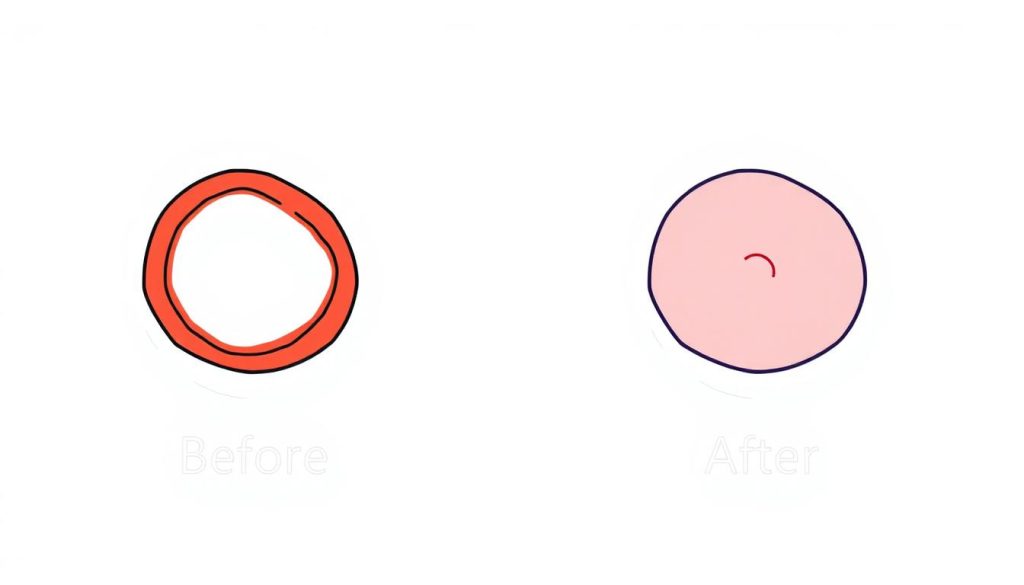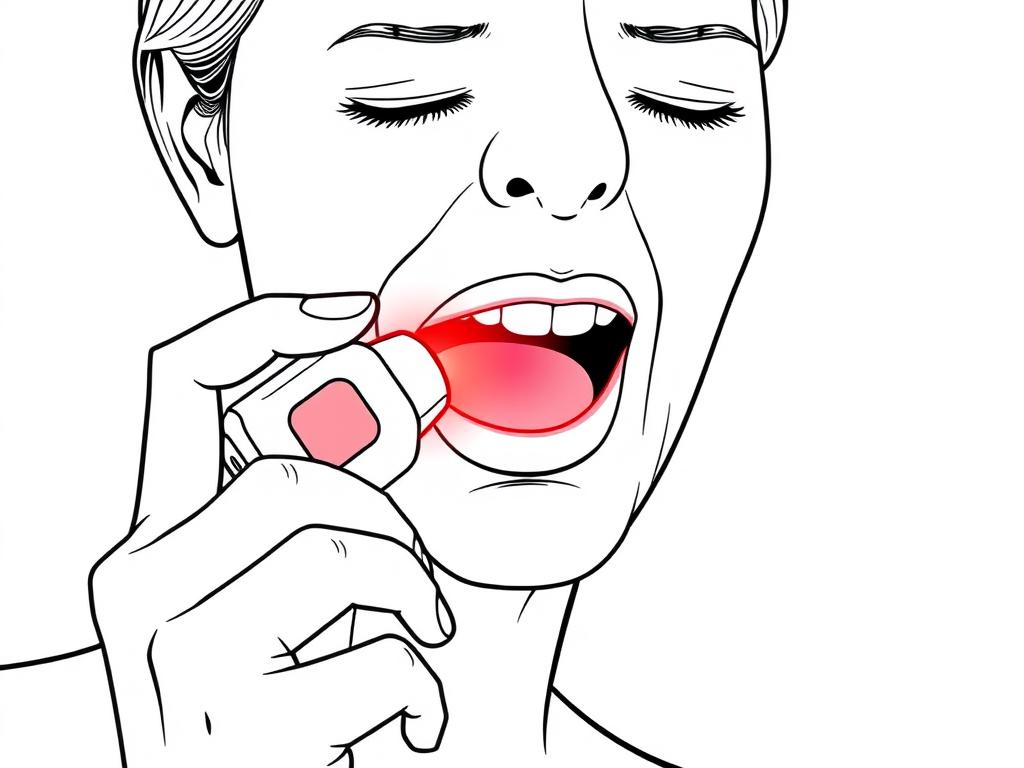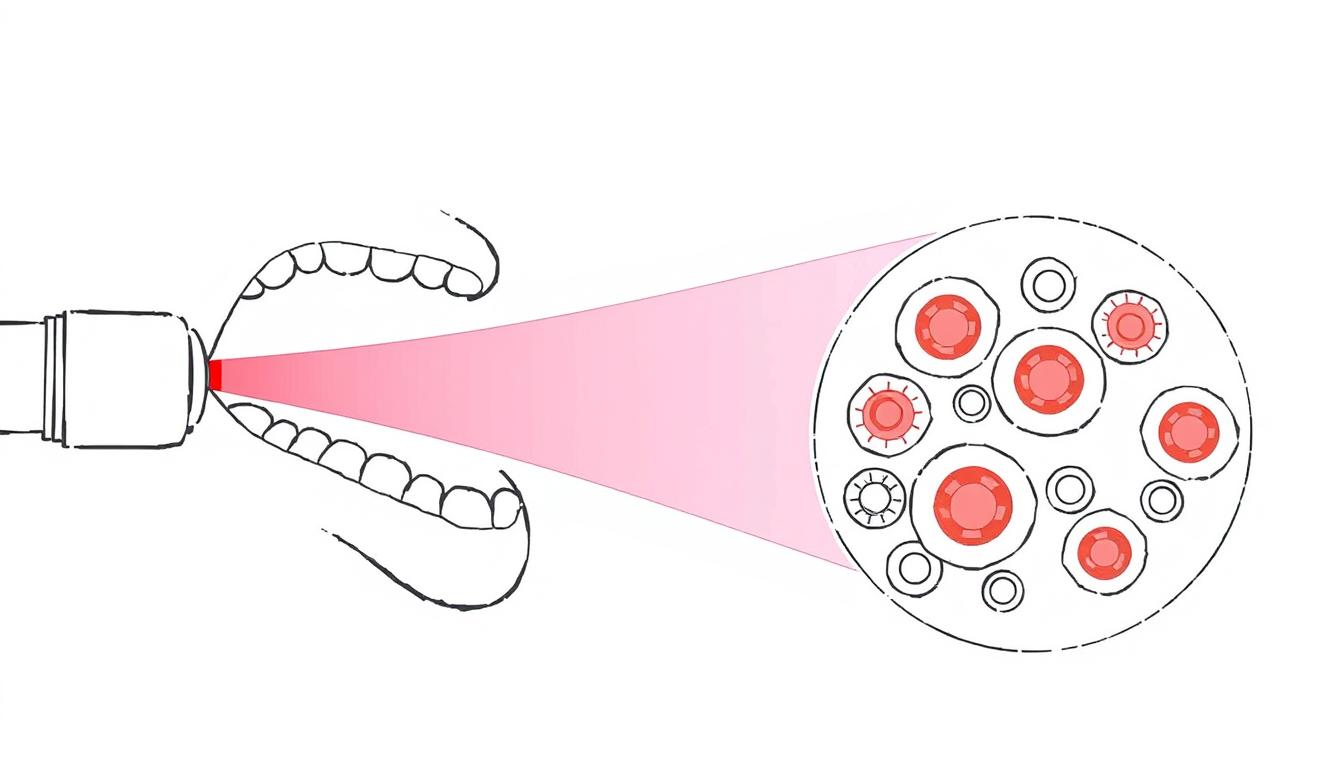Canker sores (aphthous ulcers) are small, painful lesions that develop in the soft tissues of the mouth or at the base of the gums. While rarely serious, these ulcers can make eating, drinking, and even talking uncomfortable. Traditional treatments often provide only temporary relief, leaving many sufferers searching for more effective solutions.
Red light therapy (RLT), also known as photobiomodulation or low-level laser therapy (LLLT), has emerged as a promising non-invasive treatment option. This approach uses specific wavelengths of red and near-infrared light to stimulate healing, reduce inflammation, and provide pain relief—often with remarkable speed compared to conventional treatments.
In this evidence-based guide, we’ll explore the science behind red light therapy for canker sores, examine the clinical research, compare effective devices, and provide practical tips for home treatment. Whether you’re dealing with occasional sores or recurring outbreaks, understanding this therapeutic approach could significantly improve your oral health management.
Understanding Canker Sores: Causes and Impact
Canker sores typically appear as small, round or oval lesions with a white or yellowish center and a red border. Unlike cold sores, they aren’t caused by the herpes virus and aren’t contagious. These painful ulcers can develop anywhere in the mouth, including the tongue, gums, inside of cheeks, and lips.
According to the National Institute of Dental and Craniofacial Research, approximately 20% of Americans experience recurrent canker sores, with women slightly more affected than men.
Common Triggers and Risk Factors
- Minor mouth injuries (dental work, accidental cheek bite)
- Food sensitivities (acidic or spicy foods)
- Nutritional deficiencies (B-12, iron, folate, zinc)
- Hormonal fluctuations
- Stress and immune system changes
- Certain toothpastes containing sodium lauryl sulfate
- Gastrointestinal conditions (Celiac disease, Crohn’s)
- Genetic predisposition
Conventional treatments typically include topical pain relievers, antimicrobial mouthwashes, and corticosteroid ointments. However, these approaches often provide only temporary symptom relief rather than accelerating the healing process. This is where red light therapy offers a distinct advantage.
The Science Behind Red Light Therapy for Oral Healing
How Red Light Therapy Works
Red light therapy utilizes specific wavelengths of light (typically 630-660nm red light and 810-850nm near-infrared light) that penetrate tissue at different depths. When these wavelengths reach the cells, they stimulate the mitochondria—the cellular powerhouses—to produce more adenosine triphosphate (ATP), the energy currency of cells.
This increased cellular energy production triggers a cascade of beneficial effects particularly relevant to oral wound healing:
Accelerated Tissue Repair
Stimulates fibroblast proliferation and collagen production, essential for rebuilding damaged tissue in canker sores.
Reduced Inflammation
Decreases pro-inflammatory cytokines and increases anti-inflammatory mediators, reducing swelling and discomfort.
Pain Relief
Blocks pain signals and stimulates endorphin release, providing almost immediate comfort for painful ulcers.
Critical Wavelengths for Oral Mucosal Healing
Research indicates that specific wavelengths are particularly effective for oral applications:
| Wavelength | Penetration Depth | Primary Benefits for Canker Sores |
| 630-660nm (Red) | 2-3mm | Surface tissue regeneration, antimicrobial effects |
| 810-830nm (Near-Infrared) | 3-4cm | Deeper tissue repair, enhanced blood flow |
| 850nm (Near-Infrared) | 5-6cm | Systemic anti-inflammatory effects |
Clinical Evidence: Red Light Therapy for Canker Sores
The effectiveness of red light therapy for canker sores is supported by a growing body of clinical research. Here are three key human studies that demonstrate its benefits:
Study 1: Aggarwal et al. (2014)
This controlled split-mouth study published in the Journal of Clinical and Diagnostic Research evaluated 30 patients with recurrent aphthous ulcers. Each patient had two separate ulcers, with one receiving low-level laser therapy and the other serving as a control.
Key Findings: Complete healing occurred in just 3.05 days in the laser-treated group compared to 8.90 days in the control group. Remarkably, 28 of 30 patients reported complete pain relief immediately following the first treatment session.
Study 2: Neiburger (2009)
This clinical investigation published in Chairside Magazine examined 69 patients with various intraoral ulcers treated with a single 30-second exposure to low-level red laser light (680nm wavelength).
Key Findings: A single exposure reduced 88% of painful aphthous lesions to comfortable, epithelialized levels within two days, compared to untreated lesions which took 5-10 days for similar resolution. Within 24 hours of treatment, 73.3% of patients reported complete absence of pain.
Study 3: De Souza et al. (2010)
This clinical case study published in Photomedicine and Laser Surgery examined patients with recurrent aphthous stomatitis treated with daily low-level laser applications.
Key Findings: Patients experienced immediate pain relief after the first laser application, with complete healing achieved within 4 days—significantly faster than the typical 10-14 day healing period for untreated canker sores.

These studies consistently demonstrate two significant benefits of red light therapy for canker sores:
- Rapid pain relief – Often immediate or within 24 hours of treatment
- Accelerated healing – Typically 2-4 days versus 7-14 days for untreated sores
Choosing the Right Red Light Therapy Device for Canker Sores
Key Features to Consider
When selecting a red light therapy device for treating canker sores, several factors determine effectiveness and usability:
Wavelength Spectrum
Look for devices offering both red (630-660nm) and near-infrared (810-850nm) wavelengths for comprehensive treatment of surface and deeper tissues.
Power Density
Sufficient power density (irradiance) ensures light penetrates adequately. For oral applications, 30-100mW/cm² is typically effective.
Treatment Area Size
Smaller, targeted devices work well for precise oral applications, while larger panels may offer additional benefits for systemic inflammation.
Leading Red Light Therapy Devices Compared

| Device Feature | RLT Home Total Spectrum Mini | PlatinumLED | Mito Red Light | Joovv |
| Wavelengths | 7 wavelengths (630, 660, 810, 830, 850, 1064nm + 465nm blue) | 5 wavelengths (typical) | 2-5 wavelengths (model dependent) | 2-3 wavelengths (typical) |
| Size Options for Oral Use | Mini (12″×12″, 72 LEDs) – ideal for targeted oral treatment | Multiple sizes, excellent build quality | Various sizes, user-friendly app integration | Multiple options, strong clinical partnerships |
| EMF Levels | Zero measurable EMF at ≥10 cm | Low EMF | Low EMF | Low EMF |
| Pre-programmed Modes | Yes (Pain & Inflammation, Skin, Neuro, Sleep, etc.) | Limited | Via app | Via app |
Find Your Ideal Red Light Therapy Device
Compare leading red light therapy panels side-by-side to find the perfect match for your canker sore treatment needs and budget.
RLT Home Total Spectrum Mini: Ideal for Oral Applications
For treating canker sores specifically, the Total Spectrum Mini (12″×12″, 72 LEDs) offers an excellent balance of targeted application and versatility. Its compact size makes it easy to position for oral treatments, while the seven-wavelength spectrum ensures comprehensive coverage for both surface healing and deeper tissue repair.
The device’s pre-programmed “Pain & Inflammation” mode is particularly valuable for canker sore treatment, delivering optimal wavelength combinations and pulsing patterns to maximize therapeutic benefits. For those seeking systemic benefits alongside targeted treatment, the larger Total Spectrum Ultra model provides full-body coverage with the same therapeutic wavelength spectrum.
Practical Protocol: Using Red Light Therapy for Canker Sores
Step-by-Step Treatment Guide
-
Prepare the treatment area
Gently clean your mouth with warm water. Avoid harsh mouthwashes that might irritate the sore.
-
Position the device
Hold the red light therapy device approximately 6 inches (15cm) from the affected area. For internal mouth sores, position the device at the appropriate angle to direct light to the affected area.
-
Set the treatment parameters
If using an RLT Home device, select the “Pain & Inflammation” preset mode. For other devices, set to red (660nm) and near-infrared (850nm) wavelengths if available.
-
Treatment duration
Apply for 3-5 minutes per session. For acute canker sores, treat 1-2 times daily until resolved. For prevention of recurrent sores, 2-3 sessions weekly may be beneficial.
“The most effective protocol I’ve found combines brief but consistent treatments. Most patients report significant pain reduction after the very first session, with complete healing typically occurring within 2-4 days.”
Optimizing Results: Tips from Clinical Practice
Do’s
- Treat at the first sign of a developing sore for best results
- Maintain consistent treatment schedule until fully healed
- Keep the device clean between uses
- Stay hydrated to support healing
Don’ts
- Don’t exceed recommended treatment times
- Avoid looking directly at the light source
- Don’t apply immediately after using numbing agents
- Don’t expect instant complete healing (though pain relief may be immediate)
Complementary Approaches to Support Healing
While red light therapy can significantly accelerate healing and reduce pain, combining it with these complementary approaches may enhance results:
Nutritional Support
- Vitamin B12 supplementation
- Zinc lozenges
- L-lysine
- Vitamin C for tissue repair
Dietary Modifications
- Avoid acidic and spicy foods
- Eliminate potential trigger foods
- Choose soft, bland foods during outbreaks
- Stay well-hydrated
Oral Care Adjustments
- SLS-free toothpaste
- Soft-bristled toothbrush
- Alcohol-free mouthwash
- Regular dental check-ups
For those experiencing frequent recurrences, consider systemic red light therapy with a larger device like the Total Spectrum Ultra. Full-body treatment may help address underlying inflammatory conditions that contribute to canker sore development.
Frequently Asked Questions About Red Light Therapy for Canker Sores
How quickly can red light therapy relieve canker sore pain?
Many patients report significant pain reduction immediately after the first treatment session. In the Aggarwal et al. study (2014), 28 out of 30 patients experienced complete pain relief immediately following treatment. Even when complete relief isn’t immediate, most users notice substantial improvement within 24 hours.
How many treatment sessions are typically needed?
For active canker sores, 1-2 daily sessions of 3-5 minutes each until the sore heals (typically 2-4 days with consistent treatment). For prevention in those with recurrent sores, 2-3 sessions weekly may help reduce frequency and severity of outbreaks.
Is red light therapy safe for oral use?
Yes, when used as directed. Red and near-infrared wavelengths used in therapeutic devices are non-ionizing and don’t cause tissue damage. However, always follow manufacturer guidelines and avoid looking directly at the light source. RLT Home devices feature zero measurable EMF at treatment distance and minimal flicker, enhancing safety.
Can red light therapy prevent canker sores from forming?
While research has focused primarily on treatment rather than prevention, some clinical observations suggest regular maintenance sessions may reduce the frequency and severity of outbreaks in those prone to recurrent canker sores. This preventive effect may be related to the therapy’s ability to modulate immune response and reduce systemic inflammation.
How does red light therapy compare to laser treatment at a dentist’s office?
Professional dental laser treatments typically use higher-powered devices that may provide faster results in a single session. However, at-home red light therapy offers the advantages of convenience, cost-effectiveness for multiple treatments, and the ability to begin treatment at the first sign of a developing sore. Many users find comparable results with consistent home treatment.
Conclusion: The Future of Canker Sore Treatment
Red light therapy represents a significant advancement in the management of canker sores, offering benefits that traditional treatments often cannot match: rapid pain relief, accelerated healing, and the potential for reduced recurrence with regular use.
The clinical evidence strongly supports its effectiveness, with studies consistently demonstrating healing times reduced by 50-70% compared to untreated controls. For those who suffer from frequent or severe canker sores, a quality red light therapy device represents a worthwhile investment in oral health and comfort.
When selecting a device, consider both immediate treatment needs and long-term value. The RLT Home Total Spectrum series offers comprehensive wavelength coverage and therapeutic versatility that extends beyond oral applications to support overall health and wellbeing.
Find Your Perfect Red Light Therapy Solution
Compare leading red light therapy panels side-by-side to discover which device best suits your needs, budget, and treatment goals.
As with any health intervention, consult with your healthcare provider before beginning red light therapy, particularly if you have underlying medical conditions or take medications that may cause photosensitivity.
— David, independent RLT researcher
References and Further Reading
- Aggarwal H, Singh MP, Nahar P, Mathur H, Sowmya GV. (2014). Efficacy of Low-Level Laser Therapy in Treatment of Recurrent Aphthous Ulcers – A Sham Controlled, Split Mouth Follow Up Study. Journal of Clinical and Diagnostic Research, 8(2):218-221.
- Neiburger EJ. (2009). The Effect of Low-Level Red Laser Light on the Healing of Oral Ulcers. Chairside Magazine, 4(3).
- De Souza TO, Martins MA, Bussadori SK, et al. (2010). Clinical evaluation of low-level laser treatment for recurring aphthous stomatitis. Photomedicine and Laser Surgery, 28(S2):S85-S88.
- Hamblin MR. (2017). Mechanisms and applications of the anti-inflammatory effects of photobiomodulation. AIMS Biophysics, 4(3):337-361.
- National Institute of Dental and Craniofacial Research: Canker Sores

